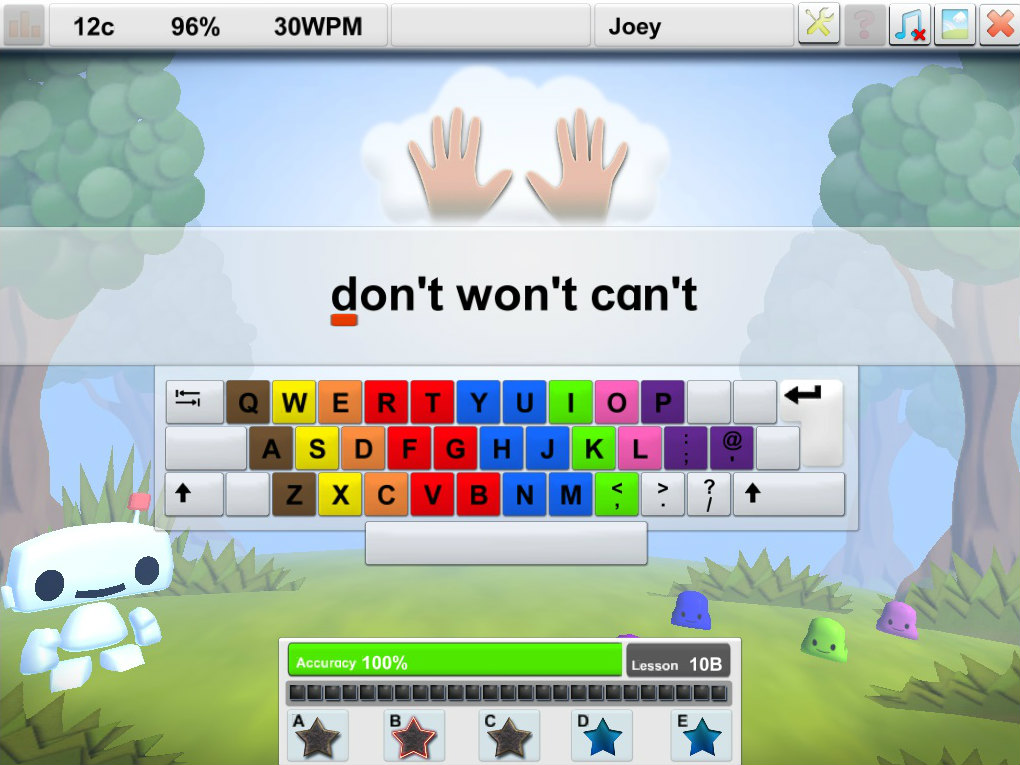Touch Typing Software for Visual Impairment
Why touch typing helps visually impaired children
Many visually impaired students find it beneficial to work on a computer/laptop as font and font size can be adjusted to suit individual needs. For VI pupils, learning to touch type early in school years is hugely beneficial, vastly increasing efficiency of computer usage and quality & quantity of work produced. Typing by touch and achieving muscle memory & automaticity is a key objective for many support teachers working with Visually Impaired children. Specialist teachers often target full automaticity by Year 6, so that when moving to Secondary school, visually impaired children are typing very quickly and confidently.
The RNIB states: “Whatever your sight difficulty, learning your way around the keyboard and learning to touch type are important skills to learn. Although great strides have been made in voice recognition software, often the most practical and accurate way for someone with sight problems to control a PC is by use of a keyboard.”


Why choose Englishtype?
Englishtype is being used very successfully with children with partial vision (it is not suitable for blind children). Features that make it supportive for other Special Needs are also great for VI children. There is a large font option in all the Lessons, which displays at approximately 48 point and choice of 8 background colours to offer different variations in contrast. (Note: not all activities offer this option).
Englishtype’s structure and different activities means the learning schedule can be designed to suit the support timetable. Learning can be done intensively, part of the normal timetable or short practice sessions over a year or two (eg. 15 mins daily) and achieve great results.
- Developed by an Educational Psychologist specialising in Dyslexia
- Designed for the UK National Curriculum and boosts literacy while teaching typing
- Unique colour coding builds muscle memory quickly
- Letters introduced in order of finger movements makes learning easier
- Multi-sensory design – see, hear, read, type
- Choice of 8 background screen colours
- Carefully selected vocabulary with 3 levels of difficulty to choose
- Programs the muscle memory with useful, high frequency words
- Extra spelling lessons for optional additional learning and wider vocabulary
- Variety of different activities to build muscle memory / unconscious skill
- Teacher Admin package for schools
- Teaching typing for 25+ years in schools and at home
- Built by award winning game designers to make learning fun






Englishtype Visual Impairment Success Stories
“We have been aiming for touch typing (ie. automaticity / muscle memory) with young people on our caseloads who, in addition to their visual reduction, have minimal underlying needs, eg. have poor fine-motor skills or conditions such as dyspraxia or those with low self-esteem. They work on the skill on a daily basis at school for 15 minutes… Our aim is for young people with vision impairment to be typing at 20 – 30 wpm with 95% accuracy by the end of Year 6. …I have found English Type to be very effective in producing good typists.”
Specialist Advisory Teacher, VI, Surrey
“As an advisory teacher for Visual Impairment in Wiltshire, I have found Englishtype invaluable. Depending on their eye condition, our pupils are issued with a laptop and a laptop camera so that they can access information on the whiteboard and also see the expressions and body language of their teachers. I had been searching for a touch typing program that was suitable for my pupils: Englishtype proved to be the answer to my prayers.
It is appropriate for different ages, linked to the National Curriculum and most importantly, FUN. The inbuilt certificates and progress feedback are really useful for maintaining motivation. The games are fun and almost addictive, resulting in hours of stimulating practice at what would otherwise be a very boring and soul destroying task. Changing background colour is also very useful for some of my pupils as this enables them to choose the option that gives them the best contrast between letters and background.
All of my pupils have made excellent progress and value the skill they have learnt. This year, (my) Year 6 students will be moving to new secondary schools with typing skills in the region of 25 words per minute and an accuracy of approximately 94%. This gives them a considerable advantage on their sighted peers.”
Specialist teacher, Wiltshire Visual Impairment Service
Explore more information on Special Needs
Dyslexia
Find out more
Dyspraxia
Find out more
Autism & Aspergers
Find out more
Visual Impairment
Find out more
